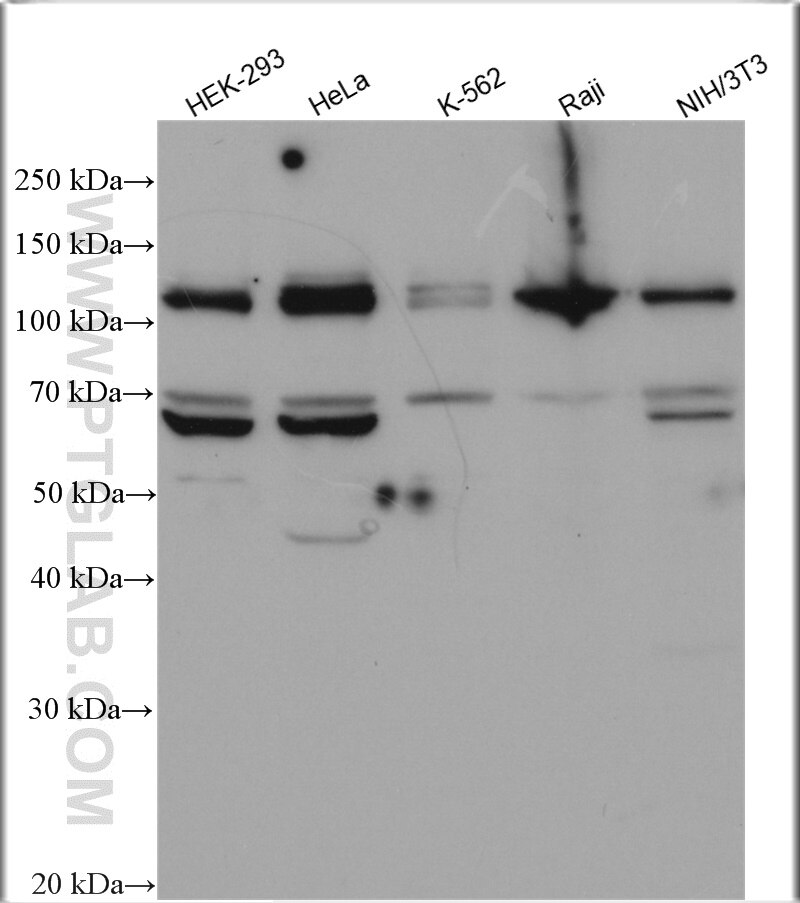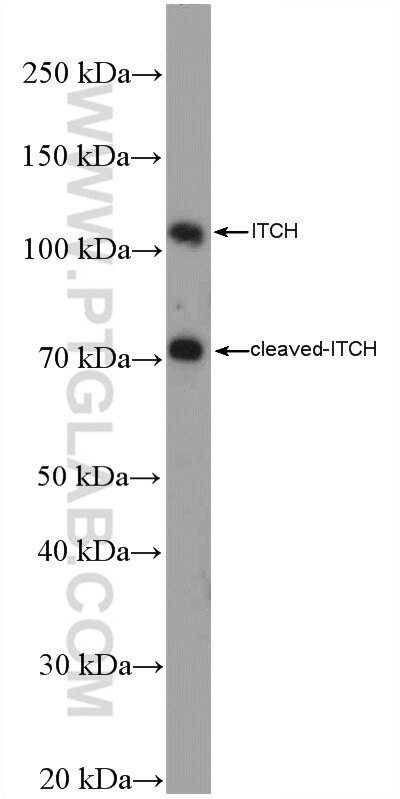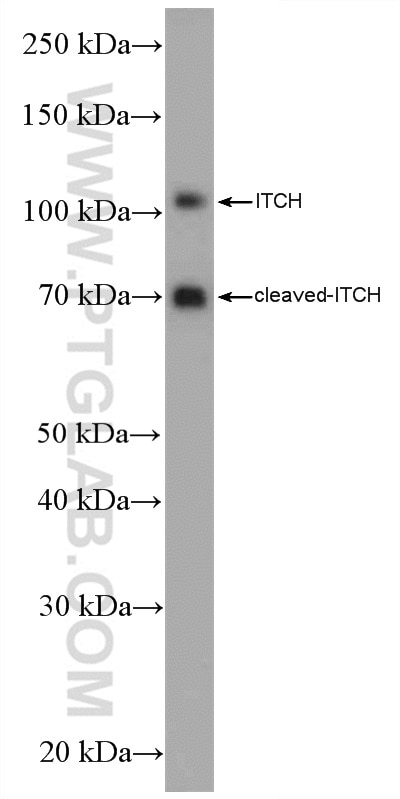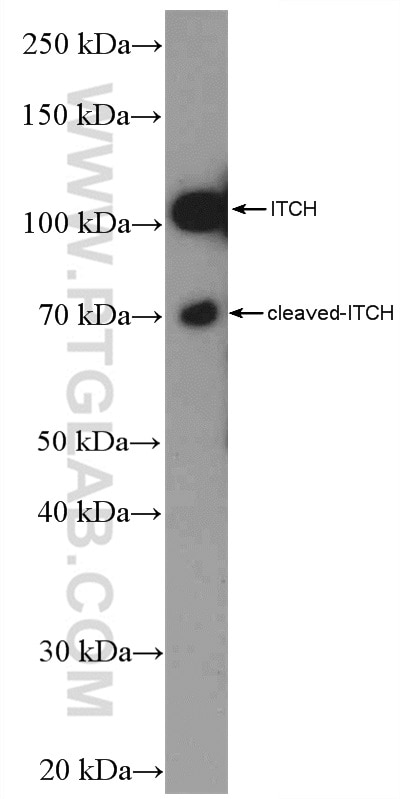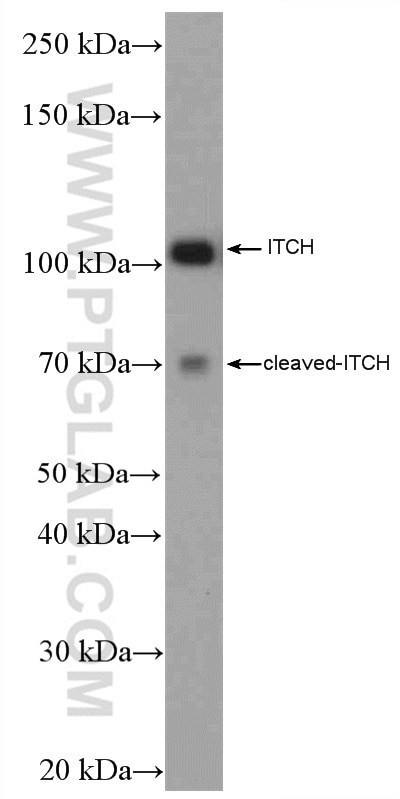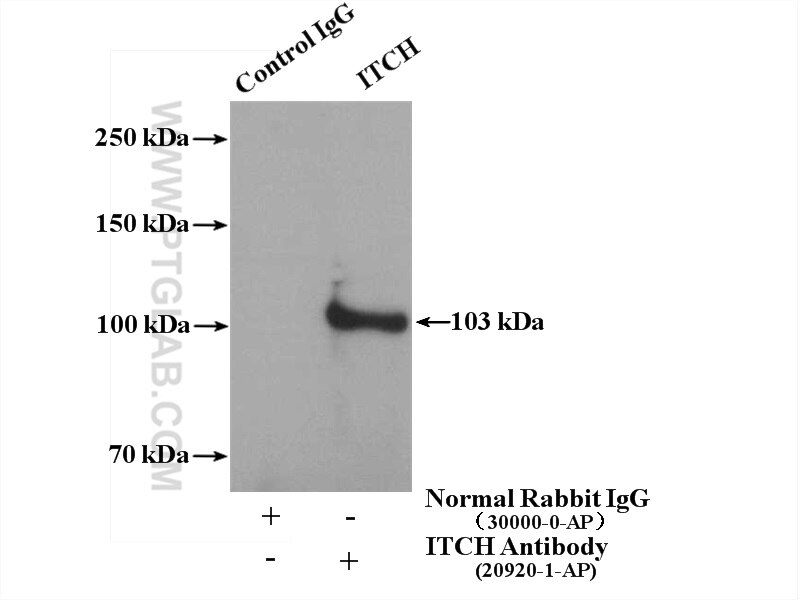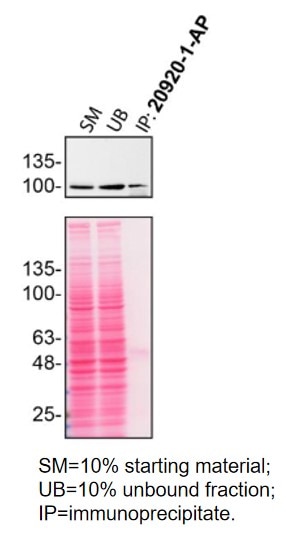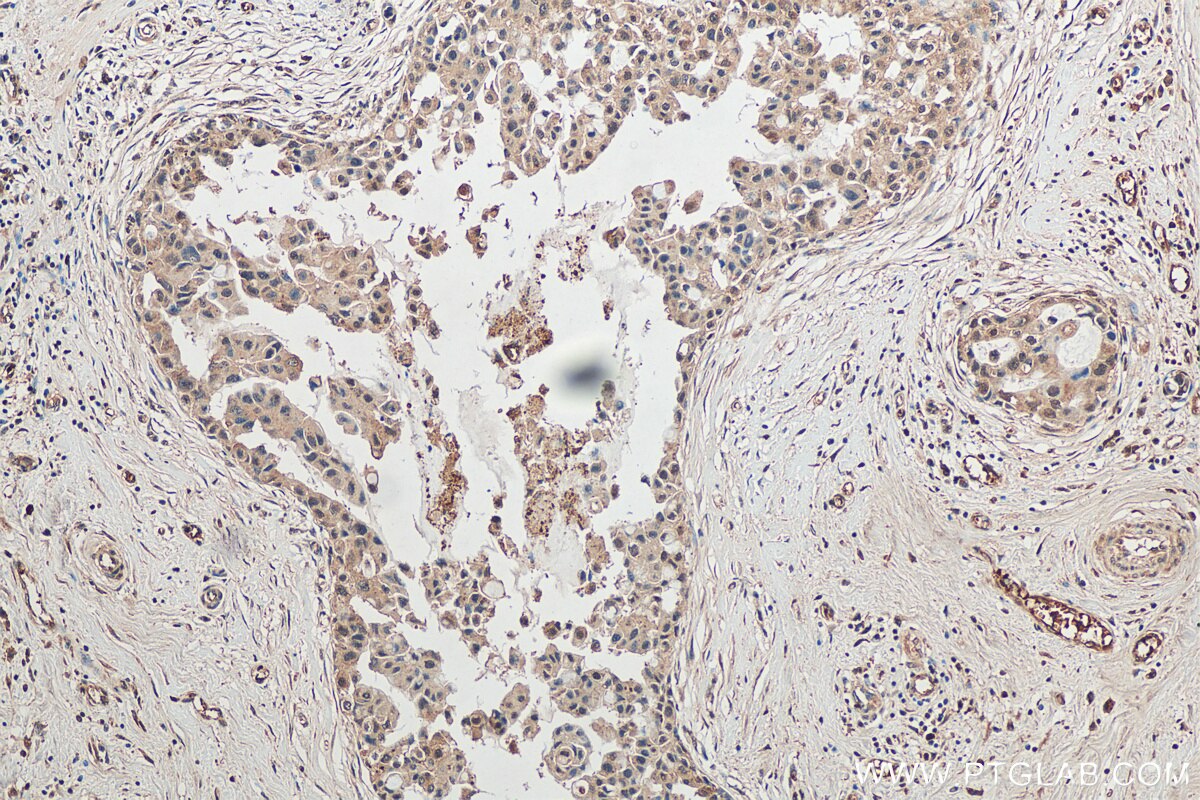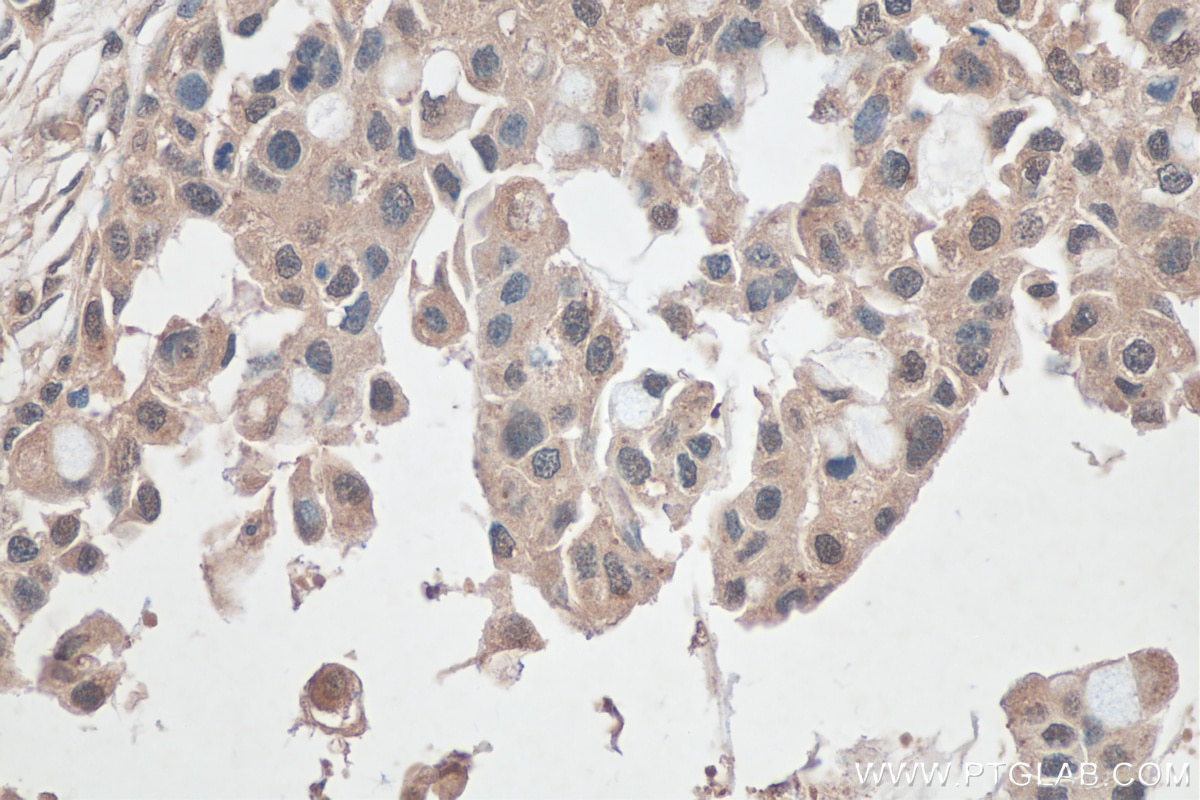- Featured Product
- KD/KO Validated
ITCH Polyklonaler Antikörper
ITCH Polyklonal Antikörper für WB, IHC, IP, ELISA
Wirt / Isotyp
Kaninchen / IgG
Getestete Reaktivität
human, Maus und mehr (1)
Anwendung
WB, IHC, IP, CoIP, ELISA
Konjugation
Unkonjugiert
Kat-Nr. : 20920-1-AP
Synonyme
Geprüfte Anwendungen
| Erfolgreiche Detektion in WB | HEK-293-Zellen, HeLa-Zellen, K-562-Zellen, NIH/3T3-Zellen, Raji-Zellen, U-251-Zellen |
| Erfolgreiche IP | HEK-293-Zellen, HeLa-Zellen |
| Erfolgreiche Detektion in IHC | humanes Mammakarzinomgewebe Hinweis: Antigendemaskierung mit TE-Puffer pH 9,0 empfohlen. (*) Wahlweise kann die Antigendemaskierung auch mit Citratpuffer pH 6,0 erfolgen. |
Empfohlene Verdünnung
| Anwendung | Verdünnung |
|---|---|
| Western Blot (WB) | WB : 1:1000-1:4000 |
| Immunpräzipitation (IP) | IP : 0.5-4.0 ug for 1.0-3.0 mg of total protein lysate |
| Immunhistochemie (IHC) | IHC : 1:50-1:500 |
| It is recommended that this reagent should be titrated in each testing system to obtain optimal results. | |
| Sample-dependent, check data in validation data gallery | |
Veröffentlichte Anwendungen
| KD/KO | See 5 publications below |
| WB | See 16 publications below |
| IHC | See 2 publications below |
| IP | See 2 publications below |
| CoIP | See 3 publications below |
Produktinformation
20920-1-AP bindet in WB, IHC, IP, CoIP, ELISA ITCH und zeigt Reaktivität mit human, Maus
| Getestete Reaktivität | human, Maus |
| In Publikationen genannte Reaktivität | human, Maus, Ratte |
| Wirt / Isotyp | Kaninchen / IgG |
| Klonalität | Polyklonal |
| Typ | Antikörper |
| Immunogen | ITCH fusion protein Ag15120 |
| Vollständiger Name | itchy E3 ubiquitin protein ligase homolog (mouse) |
| Berechnetes Molekulargewicht | 903 aa, 103 kDa |
| Beobachtetes Molekulargewicht | 103 kDa, 70 kDa |
| GenBank-Zugangsnummer | BC011571 |
| Gene symbol | ITCH |
| Gene ID (NCBI) | 83737 |
| Konjugation | Unkonjugiert |
| Form | Liquid |
| Reinigungsmethode | Antigen-Affinitätsreinigung |
| Lagerungspuffer | PBS with 0.02% sodium azide and 50% glycerol |
| Lagerungsbedingungen | Bei -20°C lagern. Nach dem Versand ein Jahr lang stabil Aliquotieren ist bei -20oC Lagerung nicht notwendig. 20ul Größen enthalten 0,1% BSA. |
Hintergrundinformationen
ITCH is an essential component of a ubiquitin-editing protein complex, comprising also TNFAIP3, TAX1BP1 and RNF11, that ensures the transient nature of inflammatory signaling pathways. It is involved in the regulation of apoptosis and reactive oxygen species levels through the ubiquitination and proteasomal degradation of TXNIP. ITCH can be cleaved by caspase-3, -6, and -7 on residue Asp240 and form a 65 kDa cleaved form (PMID: 19541840).
Protokolle
| PRODUKTSPEZIFISCHE PROTOKOLLE | |
|---|---|
| WB protocol for ITCH antibody 20920-1-AP | Protokoll herunterladen |
| IHC protocol for ITCH antibody 20920-1-AP | Protokoll herunterladenl |
| IP protocol for ITCH antibody 20920-1-AP | Protokoll herunterladen |
| STANDARD-PROTOKOLLE | |
|---|---|
| Klicken Sie hier, um unsere Standardprotokolle anzuzeigen |
Publikationen
| Species | Application | Title |
|---|---|---|
Nat Cell Biol Heat stress activates YAP/TAZ to induce the heat shock transcriptome.
| ||
Dev Cell ASK1-Mediated Phosphorylation Blocks HDAC6 Ubiquitination and Degradation to Drive the Disassembly of Photoreceptor Connecting Cilia.
| ||
Theranostics ACSS3 represses prostate cancer progression through downregulating lipid droplet-associated protein PLIN3. | ||
Clin Transl Med GRAMD4 inhibits tumour metastasis by recruiting the E3 ligase ITCH to target TAK1 for degradation in hepatocellular carcinoma.
| ||
Front Oncol Coiled-Coil Domain-Containing 68 Downregulation Promotes Colorectal Cancer Cell Growth by Inhibiting ITCH-Mediated CDK4 Degradation.
| ||
J Mol Med (Berl) Hyper-SUMOylation of SMN induced by SENP2 deficiency decreases its stability and leads to spinal muscular atrophy-like pathology. |
Rezensionen
The reviews below have been submitted by verified Proteintech customers who received an incentive for providing their feedback.
FH Chrisovalantou (Verified Customer) (10-31-2024) | Antibody was able to detech endogenous ITCH in SH-SY5Y and HEK293T on western blot
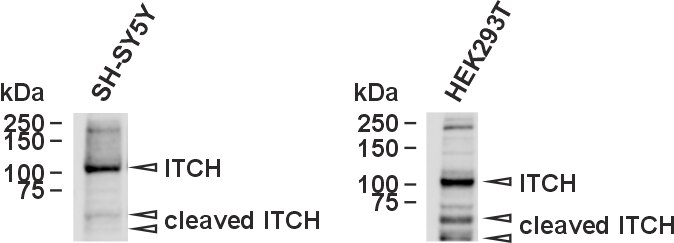 |
